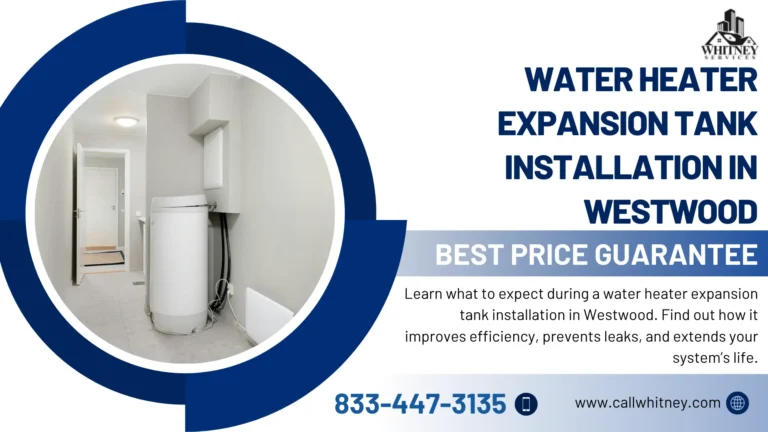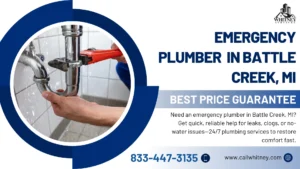Installing or upgrading a water heater expansion tank might sound like a minor plumbing project, but it’s one that makes a big difference in the long run. In a community like Westwood, where homes often feature modern plumbing systems with backflow preventers or pressure regulators, expansion tanks are essential to maintaining balance and safety within your water system.
If you’re considering this type of water heater expansion tank installation in Westwood or simply want to understand what happens during the process, this guide will walk you through everything you need to know — from how it’s installed and how much it costs, to why so many Westwood homeowners trust Whitney Services for their plumbing services.
Key Takeaways
- A water heater expansion tank protects your plumbing system by absorbing pressure caused by heated water.
- It should always be installed on the cold inlet side of your water heater.
- Proper placement, sizing, and installation help prevent leaks, damage, or premature system failure.
- Installation costs typically range between $150 and $450, depending on complexity.
- Expansion tanks are required by building codes in many cases, especially in closed plumbing systems.
- Choosing a trusted local professional like Whitney Services ensures your system is compliant, safe, and efficient.
Do I Really Need an Expansion Tank for My Water Heater?
This is one of the most common questions homeowners ask — and the short answer is yes, you probably do.
When your home’s plumbing system includes a check valve, pressure regulator, or backflow preventer, it becomes what’s called a “closed system.” That means when water inside your heater expands as it gets hot, there’s no easy way for the extra pressure to escape.
Without an expansion tank, that pressure builds up inside your pipes and water heater, which can cause leaks, worn-out valves, or even damage to your heater over time.
An expansion tank acts like a safety cushion. It absorbs excess water pressure so that your system stays balanced and your plumbing components stay protected.
Even if your home doesn’t technically require one, installing a properly sized expansion tank is still a smart investment — it helps prolong the life of your water heater, maintain even water pressure, and meet the latest plumbing standards in Westwood.
How Should a Water Heater Expansion Tank Be Installed?
A correct installation is key to ensuring long-term reliability. When you hire Whitney Services for your water heater expansion tank installation in Westwood, here’s how the process usually goes:
Assessment and Planning
Your licensed plumber begins by inspecting your plumbing system and determining whether your setup is open or closed. They’ll calculate the size of the expansion tank you need based on your water heater’s capacity and water pressure levels.
Mounting on the Cold Water Line
The expansion tank is always installed on the cold water inlet to your heater, never on the hot side. This allows it to absorb expanding water volume before it reaches the heater.
Proper Spacing and Orientation
The tank should typically be mounted about 18 inches from the cold inlet, with enough space for fittings, gauges, and servicing. It’s generally installed in a vertical position with the connection at the bottom to ensure the internal bladder functions properly.
Support and Bracing
Since the tank can add weight and pressure to your piping system, it’s secured using brackets or supports to prevent stress on fittings and to avoid leaks over time.
Connection and Testing
Once connected, your plumber will check the air pressure inside the tank, purge any air in the lines, and test for leaks. Everything is fine-tuned to meet local plumbing codes and ensure safety.
By the time your plumber finishes, your expansion tank will blend neatly into your existing plumbing system — safely, securely, and efficiently.
How Far Should the Expansion Tank Be from the Water Heater?
While every setup is unique, most professional plumbers install the expansion tank roughly 18 inches away from the cold inlet of the water heater. This distance provides the right balance between accessibility and effectiveness. It allows the tank to properly absorb expansion pressure while keeping the plumbing easy to service in the future.
If your water heater is located in a tight area, your plumber might make adjustments, but the goal is always to keep it close enough for optimal performance and easy maintenance.
Does the Expansion Tank Go on the Hot or Cold Side?
This one’s simple — the cold side, always. The expansion tank must be connected to the cold water supply line leading into your water heater. Installing it on the hot side won’t help manage pressure properly and could even cause premature wear on your heater or fittings. Placing it correctly ensures that pressure from expanding water has somewhere to go before it causes stress on your system.
Is an Expansion Tank Required by Code?
In many parts of California, including Westwood, expansion tanks are required by code when your plumbing system is closed. That means if your system has a check valve, pressure-reducing valve, or backflow preventer, you’ll need an approved expansion control device.
Even when it’s not required, it’s considered a best practice. Most water heater manufacturers also recommend installing an expansion tank to meet warranty conditions and ensure system longevity.
A licensed plumber from Whitney Services will confirm local code requirements before starting work, so you can feel confident your installation is compliant.
What Happens If You Don’t Install an Expansion Tank?
Skipping an expansion tank might save you a few dollars up front, but it can cause big problems later on. Without one, the pressure created by expanding water has nowhere to go. Over time, this can lead to:
- Leaks in your plumbing connections
- Premature failure of valves and joints
- Constant dripping from the temperature and pressure relief valve
- Decreased lifespan of your water heater
- Voided warranties if the manufacturer requires an expansion tank
Essentially, an expansion tank gives your water system a way to “breathe.” Without it, you risk costly repairs and potential safety hazards.
How Much Does It Cost to Install an Expansion Tank on a Water Heater?
The cost of a water heater expansion tank installation in Westwood varies depending on the type of system, labor rates, and accessibility. On average:
- The expansion tank itself costs between $40 and $200, depending on brand and size.
- Labor typically adds $100 to $250, depending on how complex your system is.
- The total installation cost usually falls between $150 and $450 for most homeowners.
If your plumbing setup requires additional work — like adding shut-off valves, pressure gauges, or re-routing lines — your total may be a bit higher. The best part? When you choose Whitney Services, you’ll get a clear, upfront estimate so you know exactly what you’re paying for before any work begins.
Why Choose Whitney Services
At Whitney Services, we take pride in providing high-quality, honest, and efficient plumbing services in Westwood. Our experienced team understands the local building codes, water quality, and the unique challenges of Westwood homes.
Here’s why homeowners continue to trust us:
- Licensed and certified plumbers who get the job done right the first time.
- Transparent pricing with no hidden fees.
- Top-quality materials designed for long-term performance.
- Clean, respectful service — we treat your home like our own.
- Full post-installation testing and inspection to ensure everything works perfectly.
- Reliable support even after the job is complete.
When you hire Whitney Services for water heater installation in Westwood, you’re getting more than a service call — you’re getting peace of mind.
What to Expect (The Whitney Services Difference)
Friendly Consultation
We start with a simple conversation about your water heater setup, plumbing system, and what you’re hoping to achieve.
On-Site Inspection
Our plumber visits your home, checks your existing water heater, and identifies where and how to install the expansion tank.
Clear Estimate
You’ll receive a detailed, transparent quote that outlines parts, labor, and any necessary permits.
Professional Installation
We install your expansion tank following local code and best practices — ensuring it’s secure, leak-free, and pressure-tested.
System Testing and Walkthrough
Once complete, we’ll show you how your new setup works and how to keep it running smoothly for years to come.
Follow-Up and Support
Our service doesn’t stop at water heater installation. If you have questions or notice anything unusual, we’re always just a call away.
Conclusion
A water heater expansion tank installation in Westwood is one of those upgrades that pays off quietly but significantly. It helps protect your plumbing, extend the life of your heater, and keeps your home’s water system running smoothly. Whether you’re replacing an old unit or adding one for the first time, you deserve the peace of mind that comes from expert service.
For professional, courteous, and code-compliant plumbing services in Westwood, contact Whitney Services. From start to finish, our goal is to keep your water flowing safely, efficiently, and worry-free.
Frequently Asked Questions
Check it every few years, ideally once every three to five. A healthy tank should hold air pressure equal to your home’s water pressure. If it feels waterlogged or starts to rust, it may need replacement within six to ten years.
While it might look simple, installation involves plumbing codes, pressure testing, and proper fitting. A professional ensures it’s done safely and correctly, so you avoid leaks or code violations.
Yes, your plumber will temporarily turn off your water supply to complete the work. The process usually takes two to four hours depending on complexity.
Tank size depends on your water heater’s capacity, water pressure, and temperature settings. Many homes in Westwood use 2- to 5-gallon tanks, but a licensed plumber will size it precisely for your system.
Usually not, since they don’t store large amounts of heated water. However, if your system has a small buffer tank or operates under a closed plumbing setup, one might still be required.







